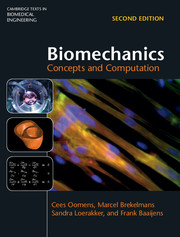[1] Adams, R. A. (2003) Calculus: A Complete Course (Addison, Wesley, Longman).
[2] Brekelmans, W. A. M., Poort, H. W. and Slooff, T. J. J. H. (1972) A new method to analyse the mechanical behaviour of skeletal parts. Acta Orthop. Scand. 43, 301–317.
[3] Brooks, A. N. and Hughes, T. J. R. (1990) Streamline upwind/Petrov–Galerkin formulations for convection dominated flows with particular emphasis on the incompressible Navier–Stokes equations. Computer Methods in Applied Mechanics and Engineering Archive Special Edition, 199–259.
[4] Carslaw, H. S. and Jaeger, J. C. (1980) Conduction of Heat in Solids (Clarendon Press).
[5] Cacciola, G. R. C. (1998) Design, Simulation and Manufacturing of Fibre Reinforced Polymer Heart Valves. Ph.D. thesis, Eindhoven University of Technology.
[6] Delfino, A., Stergiopoulos, N., Moore, J. E. and Meister, J. J. (1997) Residual strain effects on the stress field in thick wall finite element model of the human carotid bifurcation. J. Biomech. 30, 777–786.
[7] Frijns, A. J. H., Huyghe, J. M. R. J. and Janssen, J. D. (1997) A validation of the quadriphasic mixture theory for intervertebral disc tissue. Int. J. Eng. Sci. 35, 1419–1429.
[8] Fung, Y. C. (1990) Biomechanics: Motion, Flow, Stress, and Growth (Springer-Verlag).
[9] Fung, Y. C. (1993) Biomechanics: Mechanical Properties of Living Tissues, 2nd Edition (Springer-Verlag).
[10] Gerhardt, L. C., Schmidt, J., Sanz-Herrera, J. A. et al. (2012) A novel method for visualising and quantifying through-plane skin layer deformations. J. Mech. Behav. Biomed. Mat. 14, 199–207.
[11] Hill, A. V. (1938) The heat of shortening and the dynamic constants in muscle. Proc. Roy. Soc. Lond. 126, 136–165.
[12] Hughes, T. J. R. (1987) The Finite Element Method (Prentice Hall).
[13] Huyghe, J. M. R. J., Arts, T. and D. H., Campen (1992) Porous medium finite element model of the beating left ventricle. Am. J. Physiol. 262, H1256–H1267.
[14] Huxley, A. F. (1957). Muscle structure and theory of contraction. Prog. Biochem. Biophys. Chem. 7, 255–318.
[15] K., Maaden, Sekerdag, E., Schipper, P. et al. (2015) Layer-by-layer assembly of inactivated poliovirus and N-trimethyl chitosan on pH-sensitive microneedles for dermal vaccination. Langmuir 31, 8654–8660.
[16] Mow, V. C., Kuei, S. C. and Lai, W. M. (1980) Biphasic creep and stress relaxation of articular cartilage in compression. J. Biomech. Eng. 102, 73–84.
[17] Oomens, C. W. J., Campen, D. H. van and Grootenboer, H.J. (1985) A mixture approach to the mechanics of skin. J. Biomech. 20, 877–885.
[18] Oomens, C. W. J., Maenhout, M., Oijen, C. H. van, Drost, M. R. and Baaijens, F. P. T. (2003) Finite element modelling of contracting skeletal muscle. Phil. Trans. R. Soc. Lond. B 358, 1453–1460.
[19] Sengers, B. G., Oomens, C. W. J., Donkelaar, C. C. van and Baaijens, F. P. T. (2005) A computational study of culture conditions and nutrient supply in cartilage tissue engineering. Biotechnol. Prog. 21, 1252–1261.
[20] Sengers, B. G. (2005) Modeling the Development of Tissue Engineered Cartilage. Ph.D. thesis, Eindhoven University of Technology.
[21] Vlimmeren, M. A. A. van, Driessen-Mol, A., Oomens, C. W. J. and Baaijens, F. P. T. (2011) An in vitro model system to quantify stress generation, compaction and retraction in engineered heart valve tissue. Tissue Eng. Part C 17, 983–991.
[22] Ward, I. M., and Hardley, D. W. (1993) Mechanical Properties of Solid Polymers (John Wiley & Sons).
[23] Zienkiewicz, O. C. (1989) The Finite Element Method, 4th Edition (McGraw-Hill).



